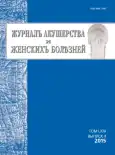Experience of use of the combined medication Vagiferon® for topical application in the treatment of bacterial vaginosis
- Authors: Metelkina S.A.1, Averina D.M.1, Kuptsova L.V.1, Guryev D.L.1
-
Affiliations:
- Regional Perinatal Center
- Issue: Vol 64, No 4 (2015)
- Pages: 95-98
- Section: Articles
- URL: https://journals.rcsi.science/jowd/article/view/1233
- DOI: https://doi.org/10.17816/JOWD64495-98
- ID: 1233
Cite item
Full Text
Abstract
Full Text
##article.viewOnOriginalSite##About the authors
Svetlana Alexandrovna Metelkina
Regional Perinatal Centerhead of consultative and diagnostic department
Daria Michailovna Averina
Regional Perinatal Centerobstetrician-gynecologist, consultative and diagnostic department
Larisa Vyacheslavovna Kuptsova
Regional Perinatal CenterHead of clinical and diagnostic laboratory
Dmitry L’vovich Guryev
Regional Perinatal Center
Email: d_guriev@mail.ru
PhD, chief physician
References
- Ефимов Б. А., Тютюнник В. Л. Бактериальный вагиноз: современный взгляд на проблему. РМЖ. 2008; 16 (1): 18.
- Кулаков В. И., Прилепская В. Н. Генитальные инфекции как фактор канцерогенеза шейки матки. В кн. Современные технологии в диагностике и лечении гинекологических заболеваний. М.: Пантори; 2004: 267-8.
- Липова Е. В., Радзинский В. Е. Бактериальный вагиноз: всегда дискуссии. Status Praesens. 2012; 7: 27-34.
- Радзинский В. Е., Ордиянц И. М. Двухэтапная терапия вагинальных инфекций. М.: Редакция журнала Status Praesens; 2012.
- Радзинский В. Е., Хамошина М. Б., Календжян А. С. и др. Эффективная коррекция нарушений биоценоза влагалища вне и во время беременности: почему это важно и что нового? Доктор.Ру. 2010; 7 (58)1: 20-6.
- ACOG Practice Bulletin. Clinical management guidelines for obstetrician-gynecologists. Vaginitis Vaginitis. ACOG Practice Bulletin N72. American College of Obstetricians and gynecologist.Obstet Gynecol. 2006; 107: 1195-206.
- Joesoef M., Schmid G. Bacterial vaginosis. In: Clinical evidence. London: BMJ Publishing Group; 2001.
- Swidsinski A., Mendling W., Loening-Baucke V. et al. An adherent Gardnerella vaginalis biofilm persists on the vaginal epithelium after standard therapy with oral metronidazole. Am. J. Obstet. Gynecol. 2008; 198: 97.e1.
Supplementary files







